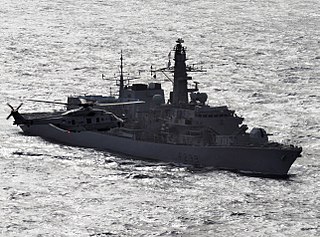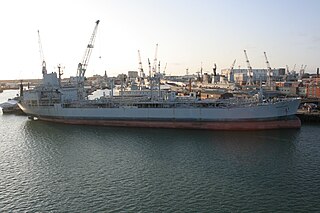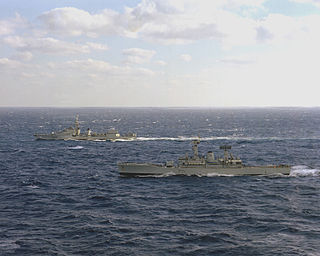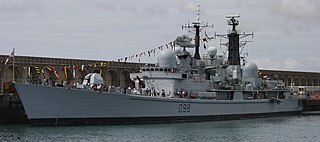| Armilla patrol | |
|---|---|
| Active | 1980s–1990s |
| Country | |
| Branch | |
| Type | Naval formation |




The Armilla patrol was the name of the Royal Navy's permanent presence in the Persian Gulf during the 1980s and 1990s.
| Armilla patrol | |
|---|---|
| Active | 1980s–1990s |
| Country | |
| Branch | |
| Type | Naval formation |




The Armilla patrol was the name of the Royal Navy's permanent presence in the Persian Gulf during the 1980s and 1990s.
The Royal Navy withdrew its forces from the Persian Gulf in 1971 (the former Flag Officer, Middle East, and Senior Naval Officer, Persian Gulf) in line with the United Kingdom's general retreat from "East of Suez". However, tensions in the area remained high and Royal Navy ships were still a frequent sight in the area. In 1980, tensions in the Middle East led to the outbreak of war between Iraq and Iran. In response to the increased danger to British shipping and other British interests, in the Persian Gulf, Armilla Patrol was set up. HMS Coventry and HMS Naiad; and later HMS Alacrity, were the first ships to patrol the Gulf of Oman and the Straits of Hormuz. There has been at least one Royal Navy ship on patrol in the area ever since. In addition to the surface combatant, the Royal Navy has also maintained an auxiliary of the Royal Fleet Auxiliary (RFA) in the Persian Gulf.
During the Falklands war, the Royal New Zealand Navy dispatched frigates to carry out the Armilla patrol duties, freeing the British ships on station for service with the Royal Navy task force tasked with freeing the Falkland Islands from the Argentine invasion.
The Armilla patrol was praised by British Prime Minister Margaret Thatcher and a call was made in parliament for an Armilla Patrol Medal to go to those serving in the Patrol at the time in 1989. [1] Ships Companies were subsequently awarded the General Service Medal (Gulf) for patrol and escort duties between 17 November 1986 and 31 October 31 October 1988. Mine countermeasures ships were awarded the GSM for service between 1 November 1988 until 28 February 1989.

Typical Armilla patrol deployments lasted for six months or so, with the supporting RFA vessel sometimes spending an aggregate total of over a year in the area. The patrol was reinforced with an aircraft carrier or task group in times of high tension or British involvement in wartime operations or by frigates or destroyers transiting the area for other operations in the Far East or Pacific.
The largest British presence in the Persian Gulf during the Armilla patrol was during the two operations against Iraq. In 1991, eight Royal Navy ships supported by a number of RFA vessels were sent to the area.
In 2003, over 30 British warships and auxiliaries were involved in the invasion of Iraq. A number of vessels, including minesweepers, survey vessels and submarines, are periodically rotated through the area to provide additional capability.
Beginning in 2006 the surface combatant deployed was tasked with patrol in the Persian Gulf and as part of Operation Oracle, the United Kingdom's assistance to the United States in its operations in the Arabian Sea, along with flexibility in tasking for operations in the Far East and Pacific.

HMS Cardiff was a British Type 42 destroyer and the third ship of the Royal Navy to be named in honour of the Welsh capital city of Cardiff.

HMS Montrose was the eighth of the sixteen-ship Type 23 or Duke class of frigates, of the Royal Navy, named after the Duke of Montrose. She was laid down in November 1989 by Yarrow Shipbuilders on the Clyde, and was launched on 31 July 1992 by Edith Rifkind, wife of Malcolm Rifkind, Secretary of State for Defence. She was commissioned into service in June 1994.

HMS Richmond is a Type 23 frigate of the Royal Navy. She was launched on 6 April 1993 by Lady Hill-Norton, wife of the late Admiral of the Fleet The Lord Hill-Norton, and was the last warship to be built by Swan Hunter Shipbuilders. She sailed from the builders on the River Tyne in November 1994. She is named for the Dukedom of Richmond.

HMS Brazen was a Type 22 frigate of the Royal Navy. She was completed three months ahead of schedule due to the Falklands War.

HMS Birmingham was a Type 42 destroyer laid down by Cammell Laird and Company, Limited, at Birkenhead on 28 March 1972, launched on 30 July 1973 by Lady Empson, wife of Sir Derek Empson and commissioned on 3 December 1976. She was named for the city of Birmingham, England.
HMS Gloucester was a Batch 3 Type 42 destroyer of the Royal Navy, built by Vosper Thorneycroft at Woolston, Southampton and launched on 2 November 1982 by The Duchess of Gloucester. Gloucester was one of the modified last four of the class to be built, having a lengthened hull design giving better seakeeping qualities, greater endurance and an external 'strake' to counter longitudinal cracking, seen on earlier ships of the type. The flight deck recognition letters worn by Gloucester were GC, and her international callsign was GBBF.

RFA Diligence was a forward repair ship of the Royal Fleet Auxiliary. Launched in 1981 as a support ship for North Sea oil rigs, she was chartered by the British government to support naval activities during the 1982 Falklands War and was later bought outright as a fleet maintenance vessel. She gave assistance to the damaged USS Tripoli and Princeton in the 1991 Gulf War, and to Sri Lanka after the 2005 tsunami. She typically had deployments of 5-8 years in support of the Trafalgar-class submarine on duty east of Suez, with a secondary role as a mothership for British and US minesweepers in the Persian Gulf. Until 2016 Diligence was set to go out of service in 2020. However in August 2016, the UK Ministry of Defence placed an advert for the sale of RFA Diligence. As of 2016 the option for the delivery of future operational maintenance and repair capability for the RFA remained under consideration. However, the 2021 British defence white paper made no specific mention of the need for this capability. In April 2023, it was revealed that the ship was to be scrapped after no suitable buyers materialised, & she was moved out of 3 Basin across to Fareham Trots to await her final journey to the scrapyard.

RFA Fort Austin is a retired British Fort Rosalie-class dry stores ship of the Royal Fleet Auxiliary.

RFA Brambleleaf (A81) was a Leaf-class support tanker of the Royal Fleet Auxiliary. Originally built as MV Hudson Deep she was chartered by the Ministry of Defence in 1980.

RFA Olna (A123) was the third and final of the three Ol-class "fast fleet tanker" of the Royal Fleet Auxiliary. Olna saw service in the Falklands War.

HMS Scylla (F71) was a Leander-class frigate of the Royal Navy (RN). She was built at Devonport Royal Dockyard, the last RN frigate to be built there as of 2016. Scylla was commissioned in 1970, taken out of service in 1993 in accordance with Options for Change, and sunk as an artificial reef in 2004 off Whitsand Bay, Cornwall.

HMS Argonaut (F56) was a Leander-class frigate that served with the Royal Navy from 1967 to 1993. She took part in the Falklands War in 1982, sustaining damage and casualties in action.

HMS Andromeda was a Leander-class frigate of the Royal Navy. She was built at HM Dockyard Portsmouth. She was launched on 24 May 1967 and commissioned into the Royal Navy on 2 December 1968. She took part in the Falklands War. She was sold to India in 1995, for use as a training ship, being renamed INS Krishna. She was finally decommissioned in May 2012.

HMS Charybdis (F75) was a Leander-class frigate of the Royal Navy (RN). She was built by the Harland & Wolff company of Belfast, and was the last ship to be built there for British naval forces until RFA Fort Victoria of the Royal Fleet Auxiliary, was launched in 1990. Charybdis was launched on 28 February 1968 and commissioned on 2 June 1969. Her nickname was "Cherry B".

Standing Royal Navy deployments is a list of operations and commitments undertaken by the United Kingdom's Royal Navy on a worldwide basis. The following list details these commitments and deployments sorted by region and in alphabetical order. Routine deployments made by the Navy's nuclear-powered submarines and their location of operations is classified.

RFA Wave Ruler is a Wave-class fast fleet tanker of the Royal Fleet Auxiliary (RFA) of the United Kingdom tasked with providing fuel, food, fresh water, ammunition and other supplies to Royal Navy vessels around the world.

RFA Wave Knight is a Wave-class fast fleet tanker of the Royal Fleet Auxiliary (RFA) of the United Kingdom tasked with providing fuel, food, fresh water, ammunition and other supplies to Royal Navy vessels around the world.

HMNZS Canterbury (F421) was one of two broad beam Leander-class frigates operated by the Royal New Zealand Navy (RNZN) from 1971 to 2005. She was built in Scotland and launched in 1970. Commissioned in 1971, Canterbury saw operational service in much of Australasia and other regions like the Persian Gulf. She undertook operations such as supporting UN sanctions against Iraq and peace-keeping in East Timor. With her sister ship HMNZS Waikato she relieved the Royal Navy frigate HMS Amazon in the Indian Ocean during the Falklands War. Early in HMNZS Canterbury's career, in 1973, she relieved the frigate HMNZS Otago, as part of a unique, Anzac, naval operation or exercise at Moruroa during anti-nuclear protests, supported by a large RAN tanker, providing fuel and a large platform for Australian media. This was due to F 421 being a more modern RNZN frigate, with then current Rn surveillance radar and ESM and a more effectively insulated frigate from nuclear fallout, with the Improved Broad Beam Leander steam plant, for example, being remote controlled and capable of unmanned operation and therefore the ship provided a more effective sealed citadel for operations in areas of nuclear explosions.

HMS York was a Batch III Type 42 destroyer of the Royal Navy. Launched on 20 June 1982 at Wallsend, Tyne and Wear and sponsored by Lady Gosling, York was the last Type 42 ordered. The ship's crest was the White Rose of York, and the "red cross with lions passant" funnel badge was derived from the coat of arms of the City of York. With a maximum speed of 34 knots, she was the Royal Navy's fastest destroyer.